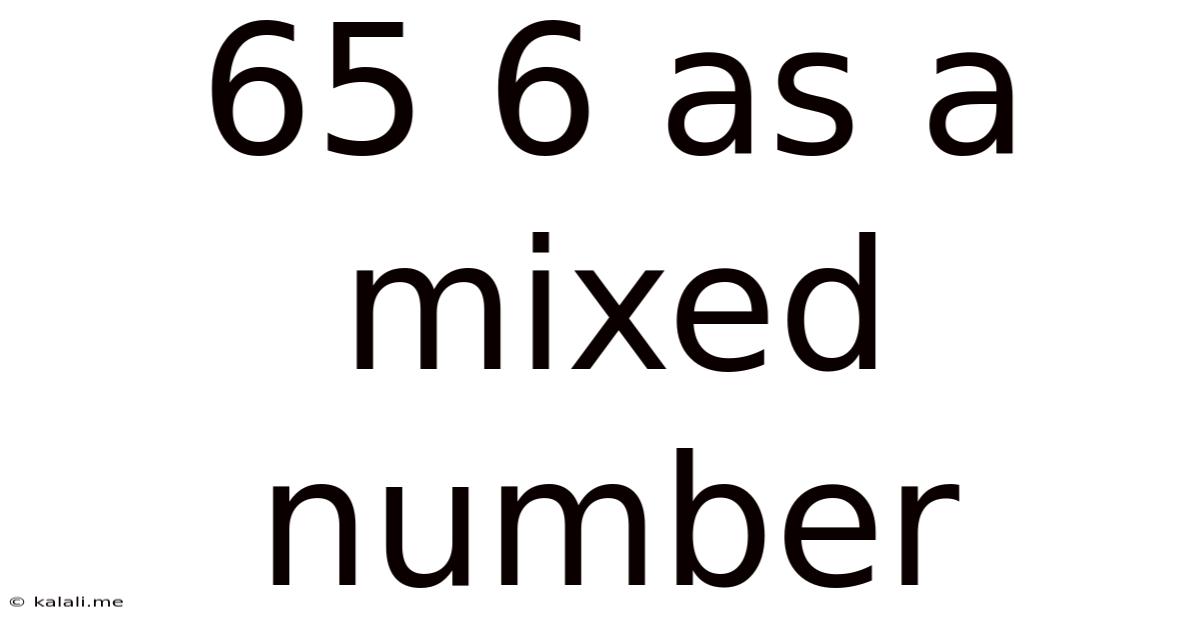65 6 As A Mixed Number
Kalali
Apr 06, 2025 · 4 min read

Table of Contents
65/6 as a Mixed Number: A Comprehensive Guide
Converting improper fractions to mixed numbers is a fundamental skill in arithmetic. This comprehensive guide will delve into the process of transforming the improper fraction 65/6 into a mixed number, explaining the underlying concepts and offering various approaches. We'll explore different methods, discuss the importance of this conversion, and provide practice problems to solidify your understanding. This guide is designed to be helpful for students of all levels, from those just learning about fractions to those looking to brush up on their math skills.
Understanding Improper Fractions and Mixed Numbers
Before diving into the conversion, let's define our key terms:
-
Improper Fraction: An improper fraction is a fraction where the numerator (the top number) is greater than or equal to the denominator (the bottom number). In our case, 65/6 is an improper fraction because 65 > 6.
-
Mixed Number: A mixed number combines a whole number and a proper fraction. A proper fraction is a fraction where the numerator is less than the denominator. The goal is to express 65/6 as a mixed number in the form of Whole Number Fraction.
Method 1: Long Division
The most straightforward method for converting an improper fraction to a mixed number is through long division. Here's how to convert 65/6 using this method:
-
Divide the numerator by the denominator: Divide 65 by 6.
6)65 -
Find the whole number: 6 goes into 65 ten times (6 x 10 = 60). This 10 becomes the whole number part of our mixed number.
-
Find the remainder: Subtract the product (60) from the numerator (65): 65 - 60 = 5. This 5 is the remainder.
-
Form the fraction: The remainder (5) becomes the numerator of the fraction, and the original denominator (6) remains the denominator. This gives us the fraction 5/6.
-
Combine the whole number and the fraction: Combine the whole number (10) and the fraction (5/6) to form the mixed number: 10 5/6.
Therefore, 65/6 as a mixed number is 10 5/6.
Method 2: Repeated Subtraction
This method is particularly useful for visualizing the conversion. It involves repeatedly subtracting the denominator from the numerator until the result is less than the denominator.
-
Repeatedly subtract the denominator: Subtract 6 from 65 repeatedly:
- 65 - 6 = 59
- 59 - 6 = 53
- 53 - 6 = 47
- 47 - 6 = 41
- 41 - 6 = 35
- 35 - 6 = 29
- 29 - 6 = 23
- 23 - 6 = 17
- 17 - 6 = 11
- 11 - 6 = 5
-
Count the subtractions: We subtracted 6 from 65 a total of 10 times. This is our whole number.
-
The remaining number is the numerator: The final result after repeated subtraction is 5. This is our new numerator.
-
Combine the whole number and the fraction: This gives us the mixed number 10 5/6.
Method 3: Factoring and Simplification (Advanced)
While not strictly necessary for this specific problem, understanding factoring can be helpful for simplifying the fraction before converting it to a mixed number, particularly with larger fractions. This method isn't as efficient for this example but offers a valuable conceptual insight for more complex scenarios. In cases where the numerator and denominator share a common factor, you can simplify the fraction before performing the division.
The Importance of Converting Improper Fractions to Mixed Numbers
Converting improper fractions to mixed numbers is crucial for several reasons:
-
Improved Understanding: Mixed numbers offer a more intuitive representation of quantities. It's often easier to grasp the meaning of 10 5/6 pizzas than 65/6 pizzas.
-
Real-world Applications: Many real-world problems involve quantities that are better expressed using mixed numbers. For example, measuring lengths, weights, or volumes often results in mixed numbers.
-
Further Calculations: Mixed numbers are often easier to use in subsequent calculations, especially when adding, subtracting, or comparing fractions. It is generally easier to add 2 1/2 + 3 1/4 than it is to add 5/2 + 13/4.
-
Problem Solving: Understanding the conversion process allows for more effective problem-solving in various mathematical contexts.
Practice Problems
To solidify your understanding, try converting the following improper fractions to mixed numbers using the methods described above:
- 23/4
- 37/5
- 49/8
- 100/12
- 115/11
Solutions:
- 5 ¾
- 7 2/5
- 6 ⅛
- 8 ⅓
- 10 5/11
Conclusion
Converting the improper fraction 65/6 to the mixed number 10 5/6 is a straightforward process that can be achieved through various methods. Understanding these different approaches not only strengthens your mathematical skills but also provides a deeper appreciation for the versatility and practical application of fractions and mixed numbers. Mastering this skill is essential for progress in mathematics and various real-world applications. By practicing the methods explained and working through the practice problems, you will solidify your understanding of this fundamental arithmetic concept. Remember to always choose the method most comfortable and efficient for you.
Latest Posts
Latest Posts
-
28 Oz Is How Many Cups
Apr 07, 2025
-
What Is The Least Common Factor Of 7 And 8
Apr 07, 2025
-
Does Chlorine And Sulfur Form An Ionic Compound
Apr 07, 2025
-
How Much Is 1 7 Fl Oz
Apr 07, 2025
-
How Many Millimeters Are In 6 5 Centimeters
Apr 07, 2025
Related Post
Thank you for visiting our website which covers about 65 6 As A Mixed Number . We hope the information provided has been useful to you. Feel free to contact us if you have any questions or need further assistance. See you next time and don't miss to bookmark.